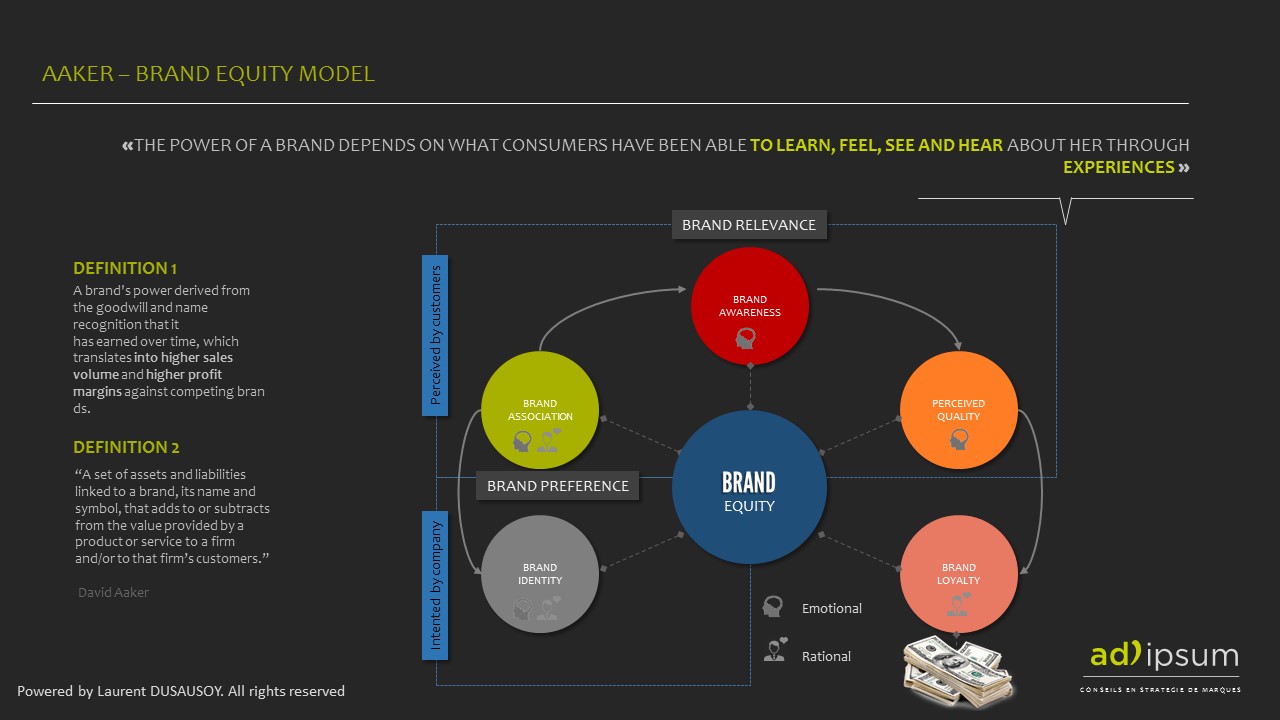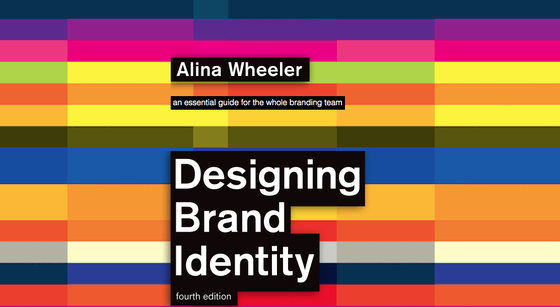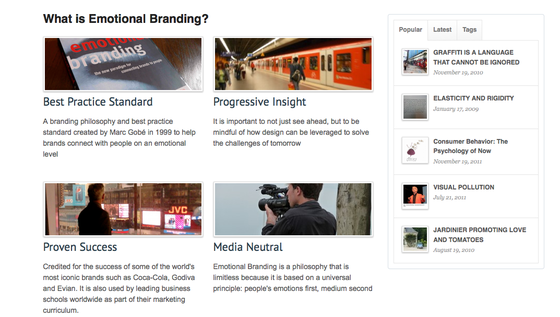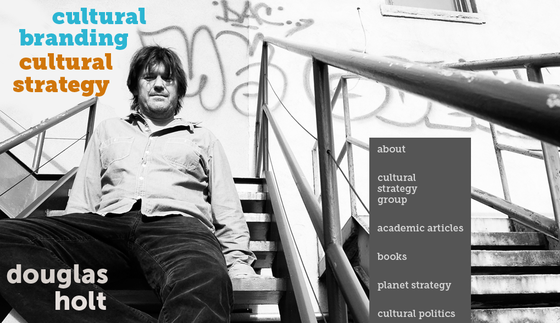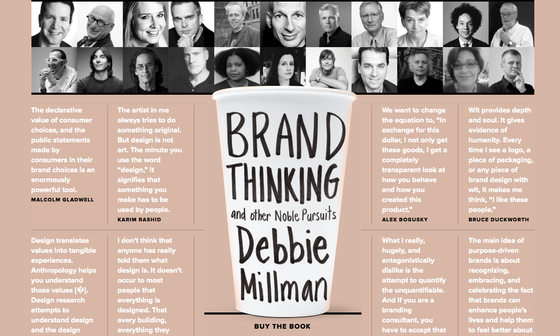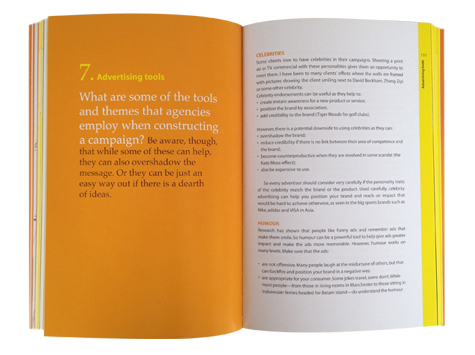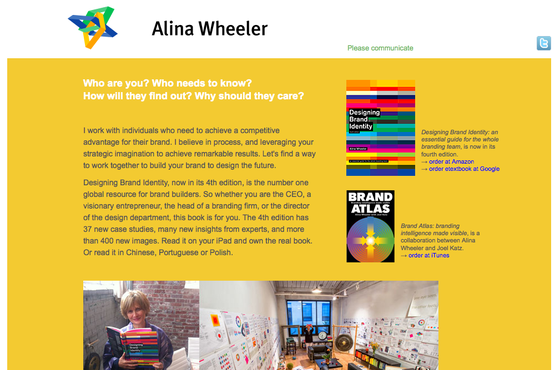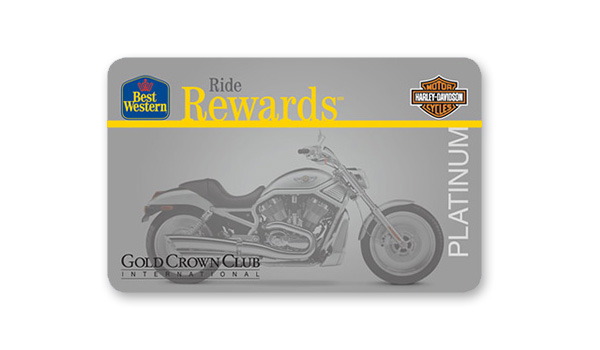Branding
Relentlessly Relevant Brands: The Role Models
Posted January 12, 2016
Earlier this week Forbes ran an article announcing the release of a Prophet study which ranks the “relentless relevance” of 400 top brands from 27 categories. The respondents were U.S. consumers, active in the category and familiar with the brand, so the results go beyond visibility and reach to understand attachment to the brand.
Relentless relevance was measured by four dimensions:
- Customer Obsessed: Being important to a person’s life, connecting emotionally, and creating happiness.
- Ruthlessly Pragmatic: Makes life easier by being dependable, available, and delivering a consistent experience.
- Distinctively Inspired: Inspires, has a meaningful purpose, is trustworthy, and in-touch.
- Pervasively Innovative: Pushes the status quo, engages with customers in new and creative ways, and finds new ways to address unmet needs.
Brands that are relentlessly relevant are likely to be dominant leaders of a subcategory which is usually the best route to growth as I explained in my book Brand Relevance.
Several findings caught my eye:
- The top three brands, Apple, Samsung and Microsoft, are considered highly reliable enablers of what is important in the life of respondents. They score high across all dimensions. All of these brands are highly visible and have been the subject of positive news as well as controversy. But at the end of the day, their customers still love them, and loyalty wins. I recall hearing Phil Knight commenting on why he was running highly-controversial Nike ads. He noted that all he cared about was his core target markets, and they loved them. It’s that intense focus on the core customer that creates brand enthusiasts that stick with your brand through thick and thin.
- Involvement is a driver of relentless relevance. The scale “engages me in new and creative ways” helped give the brands PlayStation, Xbox, EA and Etsy a place in the top 50. Etsy, admittedly a surprise to me, helps those in the Maker Movement reach a bigger pool of shoppers. The e-commerce company has devoted itself to building an authentic, people-driven marketplace, with 23 million buyers to date.
- The Ruthlessly Pragmatic (dependable) dimension is more influential than expected in weighting the relevance score. After the first three brands, three of the next five, Netflix, Chick-fil-a and Spotify all scored extremely high on Ruthlessly Pragmatic dimension that includes concepts like availability, consistent experience, dependability, and making life easier. It is great to be inspiring, innovative and central to a person’s lifestyle but simply delivering your brand promise is of very high value to consumers.
- Fifteen of the top 50 brands were classic brand names that largely delivered functional benefits, or so it seems. Leading the way with positions in the top 25 were Betty Crocker, Band-Aid, Clorox, KitchenAid and Folgers. All were extremely high on the Ruthlessly Pragmatic dimension, reinforcing the hypothesis that delivering to expectations may not be glamorous, but can drive a brand’s ability to create and keep a loyal segment which can be the basis of a healthy long-term business. There’s also likely to be some emotional benefit linked to the nostalgia of growing up with these brands – they become part of the fabric of people’s lives. Likely connected: Many of these brands had relatively high scores on the “trust” dimension as well.
- Four of the top brands including Netflix at number 5, Spotify at number 8, Pandora at Number 19, and YouTube at number 43 are Internet media brands and score high on the “important in my life” dimension. Two more, Pixar at 11 and Disney at 24, are entertainment brands and were extremely high on both “makes me happy” and “connects with me emotionally.” Not only are these companies providing a more fun experience for their customers, but they are innovating the experience and constantly keeping it fresh and relevant in consumer’s lives.
- Seven fashion-connected brands populated the top 50 including Nike, Sephora, M·A·C, North Face, Under Armour, Adidas and Victoria Secret. Many had high scores on the “distinctively inspired” dimension. All involve a high level of involvement and energy as well.
Relentless relevance measured on those that are active in the category and familiar with the brand provide a key brand equity indicator that is not available on other brand strength scales and represents a brand relationship that is a key to business success.
Strategic Brand Agility
From David Aacker.
In these dynamic times, customers change, trends disrupt strategies, technologies transform the competitive context, and new subcategories emerge. As a result, there is a pressing need to be agile; to have the ability to adjust the offering, the core brand position, the value proposition, and customer relationship.
Strategic brand agility does not mean to change the brand or its presentation to satisfy a manager who is bored with the current brand strategy and wants to put his or her mark on the brand. Nor does it mean a misguided effort based on the assumption that a brand deficiency is holding back growth when actually the brand is not the problem in the first place.
What then is strategic brand agility?
A strategically brand agile firm is one that can detect and respond quickly and strategically to significant changes in the marketplace. Such firms need to have four assets or capabilities – (1) flexible brand strategy, (2) market sensing processes, (3) the ability to identify and frame strategic issues, and (4) accelerated brand strategy response capability.
Brand association: the example of Harrod's and Aston MArtin.
When 2 brands share similar DNA, heritage, country soft power and customers, then brand associations are natural...and efficient. This kind of association enhances the awareness and the perceived quality of both brands.
See the example between Harrod's and Aston Martin:
Harrod's and Aston Martin co branding
David Aaker developed a model in this regard (cf David Aaker’s brand equity model). See below my presentation.
Want to know more about brand association ?
Want to know more about David AAker' books ?
Keller's Brand Equity Model Building a Powerful Brand
By the Mind Tools Editorial Team.
Do you know what makes a brand strong? And if you had to make yours stronger, would you know how to do it?
Many factors influence the strength of a particular product or brand. If you understand these factors, you can think about how to launch a new product effectively, or work out how to turn a struggling brand into a successful one.
In this article, we'll look at Keller's Brand Equity model. This tool highlights four steps that you can follow to build and manage a brand that customers will support.
Overview
Keller's Brand Equity Model is also known as the Customer-Based Brand Equity (CBBE) Model. Kevin Lane Keller, a marketing professor at the Tuck School of Business at Dartmouth College, developed the model and published it in his widely used textbook, "Strategic Brand Management."
The concept behind the Brand Equity Model is simple: in order to build a strong brand, you must shape how customers think and feel about your product. You have to build the right type of experiences around your brand, so that customers have specific, positive thoughts, feelings, beliefs, opinions, and perceptions about it.
When you have strong brand equity, your customers will buy more from you, they'll recommend you to other people, they're more loyal, and you're less likely to lose them to competitors.
The model, seen in Figure 1, illustrates the four steps that you need to follow to build strong brand equity.
Figure 1 – Keller's Brand Equity Model

From "Strategic Brand Management: Building, Measuring, and Managing Brand Equity" by Kevin Lane Keller. © Pearson Education Limited 2013.
The four steps of the pyramid represent four fundamental questions that your customers will ask – often subconsciously – about your brand.
The four steps contain six building blocks that must be in place for you to reach the top of the pyramid, and to develop a successful brand.
Applying the Model
Let's look at each step and building block in detail, and discuss how you can apply the framework and strengthen your brand.
Step 1: Brand Identity – Who Are You?
In this first step, your goal is to create "brand salience," or awareness – in other words, you need to make sure that your brand stands out, and that customers recognize it and are aware of it.
You're not just creating brand identity and awareness here; you're also trying to ensure that brand perceptions are "correct" at key stages of the buying process.
Application
To begin, you first need to know who your customers are. Research your market to gain a thorough understanding of how your customers see your brand, and explore whether there are different market segments ![]() with different needs and different relationships with your brand.
with different needs and different relationships with your brand.
Next, identify how your customers narrow down their choices and decide between your brand and your competitors' brands. What decision-making processes do your customers go through when they choose your product? How are they classifying your product or brand? And, when you follow their decision making process, how well does your brand stand out at key stages of this process?
You are able to sell your product because it satisfies a particular set of your customers' needs; this is your unique selling proposition ![]() , or USP. You should already be familiar with these needs, but it's important to communicate to your customers how your brand fulfills these. Do your clients understand these USPs when they're making their buying decisions?
, or USP. You should already be familiar with these needs, but it's important to communicate to your customers how your brand fulfills these. Do your clients understand these USPs when they're making their buying decisions?
By the end of this step, you should understand whether your clients perceive your brand as you want them to, or whether there are specific perceptual problems that you need to address – either by adjusting your product or service, or by adjusting the way that you communicate your message. Identify the actions that you need to take as a result.
Step 2: Brand Meaning – What Are You?
Your goal in step two is to identify and communicate what your brand means, and what it stands for. The two building blocks in this step are: "performance" and "imagery."
"Performance" defines how well your product meets your customers' needs. According to the model, performance consists of five categories: primary characteristics and features; product reliability, durability, and serviceability; service effectiveness, efficiency, and empathy; style and design; and price.
"Imagery" refers to how well your brand meets your customers' needs on a social and psychological level. Your brand can meet these needs directly, from a customer's own experiences with a product; or indirectly, with targeted marketing, or with word of mouth.
A good example of brand meaning is Patagonia®. Patagonia makes high quality outdoor clothing and equipment, much of which is made from recycled materials.
Patagonia’s brand performance demonstrates its reliability and durability; people know that their products are well designed and stylish, and that they won't let them down. Patagonia’s brand imagery is enhanced by its commitment to several environmental programs and social causes; and its strong “reduce, reuse, recycle” values make customers feel good about purchasing products from an organization with an environmental conscience.
Application
The experiences that your customers have with your brand come as a direct result of your product's performance. Your product must meet, and, ideally, exceed their expectations if you want to build loyalty. Use the Critical to Quality Tree ![]() and Kano Model Analysis
and Kano Model Analysis ![]() models to identify your customers' needs, and then explore how you can translate these needs into a high quality product.
models to identify your customers' needs, and then explore how you can translate these needs into a high quality product.
Next, think carefully about the type of experience that you want your customers to have with your product. Take both performance and imagery into account, and create a "brand personality." Again, identify any gaps ![]() between where you are now and where you want to be, and look at how you can bridge these.
between where you are now and where you want to be, and look at how you can bridge these.
Step 3: Brand Response – What Do I Think, or Feel, About You?
Your customers' responses to your brand fall into two categories: "judgments" and "feelings." These are the two building blocks in this step.
Your customers constantly make judgments about your brand and these fall into four key categories:
- Quality: Customers judge a product or brand based on its actual and perceived quality.
- Credibility: Customers judge credibility using three dimensions – expertise (which includes innovation), trustworthiness, and likability.
- Consideration: Customers judge how relevant your product is to their unique needs.
- Superiority: Customers assess how superior your brand is, compared with your competitors' brands.
Customers also respond to your brand according to how it makes them feel. Your brand can evoke feelings directly, but they also respond emotionally to how a brand makes them feel about themselves. According to the model, there are six positive brand feelings: warmth, fun, excitement, security, social approval, and self-respect.
Application
First, examine the four categories of judgments listed above. Consider the following questions carefully in relation to these:
- What can you do to improve the actual and perceived quality of your product or brand?
- How can you enhance your brand's credibility?
- How well does your marketing strategy communicate your brand's relevancy to people's needs?
- How does your product or brand compare with those of your competitors?
Next, think carefully about the six brand feelings listed above. Which, if any, of these feelings does your current marketing strategy focus on? What can you do to enhance these feelings for your customers?
Identify actions that you need to take as a result of asking these questions.
Step 4: Brand Resonance – How Much of a Connection Would I Like to Have With You?
Brand "resonance" sits at the top of the brand equity pyramid because it's the most difficult – and the most desirable – level to reach. You have achieved brand resonance when your customers feel a deep, psychological bond with your brand.
Keller breaks resonance down into four categories:
- Behavioral loyalty: This includes regular, repeat purchases.
- Attitudinal attachment: Your customers love your brand or your product, and they see it as a special purchase.
- Sense of community: Your customers feel a sense of community with people associated with the brand, including other consumers and company representatives.
- Active engagement: This is the strongest example of brand loyalty. Customers are actively engaged with your brand, even when they are not purchasing it or consuming it. This could include joining a club related to the brand; participating in online chats, marketing rallies, or events; following your brand on social media; or taking part in other, outside activities.
Application
Your goal in the last stage of the pyramid is to strengthen each resonance category.
For example, what can you do to encourage behavioral loyalty? Consider gifts with purchase, or customer loyalty programs.
Ask yourself what you can do to reward customers who are champions of your brand. What events could you plan and host to increase customer involvement with your brand or product? List the actions that you could take.
Example
Julie has recently been put in charge of a project to turn around an under-performing product. The product is a high quality, fair trade, organic tea, but it's never achieved the sales and customer loyalty that the organization expected. Julie decides to use the brand equity pyramid to think about the turnaround effort.
Step 1: Brand Identity
Julie's target customers are mid to high income, socially conscious women.
After careful analysis, she knows that she is marketing in the correct category, but she realizes that her marketing efforts aren't fully addressing customer needs. She decides to change the message from "healthy, delicious tea," to "delicious tea, with a conscience," which is more relevant and meaningful to her target market.
Step 2: Brand Meaning
Next, Julie examines the product's meaning, and looks at how the company communicates that meaning to its customers.
The performance of the tea is already moderately high; it's a single-source, fair trade tea of a higher quality than the competition's product. After assessing the organization's service effectiveness, Julie is disappointed to find that many of her representatives lack empathy with customers who complain. So, she puts everyone through a comprehensive customer service class to improve responses to customer complaints and feedback.
Last, Julie decides to post to the company's website personal stories from the fair trade farmers who grow and pick the tea. By doing this, she aims to educate customers on how beneficial this practice is for people around the world.
Step 3: Brand Response
After going over the four brand response judgments, Julie realizes that perceived quality might be an issue. The tea itself is high quality, but the pack size is smaller than the ones her competitors use. Julie doesn't want to lower the price, as this might affect how customers assess quality, so she decides to offer more tea in each box in order to surpass customer expectations.
She also decides to enhance the tea's credibility by becoming fair trade certified through an independent third-party organization.
Step 4: Brand Resonance
Julie knows that her target customers care deeply about fair trade. She decides to promote the organization's efforts by participating in a number of fair trade events around the country.
She also sets up a social networking framework to involve customers in the organization's fair trade efforts, and she creates a forum on the company website where customers can discuss issues surrounding fair trade. She also commits to championing the efforts of other fair trade organizations.
Key Points
Keller's Brand Equity model is also known as the Customer-Based Brand Equity (CBBE) Model. Kevin Lane Keller developed the model and published it in his widely used textbook, "Strategic Brand Management."
Within a pyramid, the model highlights four key levels that you can work through to create a successful brand. These four levels are:
- Brand identity.
- Brand meaning.
- Brand responses.
- Brand relationships.
Within these four levels are six building blocks that further help with brand development. These six building blocks are salience, performance, imagery, judgments, feelings, and resonance.
Top 10 books on Branding
A red can
A white apple
Multi-colored letters
If you live in the civilized world (and since you’re on a computer, I’m guessing you do) you understand the four things I mentioned above. They’re the logos of four of the most iconic American brands: Nike, Coca-Cola, Apple, and Google. Each one of these now giant corporations started their brand as a small company, but what made them grow so large that they exist in the back of our minds? It’s not just the great products each of these companies make, but the logos, commercials, and ideology that make up their brands. If you want to make your brands work as well as the big guys, check out these books.
Designing Brand Identity by Alina Wheeler
The first thing to learn when trying to master something is the basics, and this book gives you the essential elements you need to know before you start making your brand. It uses case studies from major marketing companies so you know it’s advice will have real world applications.
The Science and Art of Branding by Giep Franzen and Sandra Moriarty
This book not only gives you an in depth look at what makes effective marketing, but it also switches the perspective from the producer to the consumer. It looks at what makes the public want to buy.
Emotional Branding by Marc Gobé
This book said social media would be one of the biggest players in marketing to a younger generation. So what? It said it in 2001. And if that's not enough, it's techniques helped Barack Obama get elected.
How Brands Become Icons by Douglas Holt
The best way to learn is from studying the best and this book helps you do that. Read about how brands like Coca-Cola went from simple to iconic.
Brand Thinking and Other Noble Pursuits by Debbie Millman
One of the more lofty books about branding, this book examines why people feel the need to express themselves through what they buy. In a market saturated by millions of choices, this book explores how the consumer decides.
Create, Convince, Connect by Jorg Dietzel
Dietzel makes branding sound as easy as using a 2-in-1 shampoo and conditioner in this book. The book examines creating something that not only convinces people to buy the product, but to connect on personal level with your company's philosophy through branding.
Logo Design Love by David Airey
A brand is nothing without an image behind it. This book not only shows you what makes a great logo, but shows you how to love it’s intricacies.
Designing Brand Experiences by Robin Landa
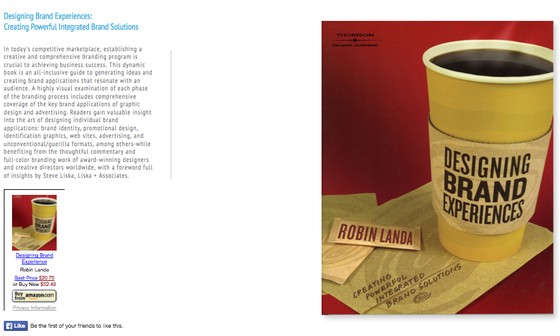
Brands are more than just products; they’re a collections of the fun times and memories we have when consumers are using the product. This book shows you how to introduce potential customers to the idea of the experiences they could have with your brand.
Brand Atlas by Alina Wheeler
If you're into making logos, you're probably a visual thinker. This book gives you information on the world of branding accompanied by well-designed and elegant graphs. It makes the secrets of marketing visible on the page instead of buried in text.
Branding Yourself by Erik Deckers and Kyle Lacy
When the generation that grew up watching YouTube instead of TV and chatting on Facebook during recess comes of age, the individual will be the most important thing to brand. Celebrities have been making themselves brands for years, but social media gives us the power to do it right, and this book will help you make your brand more Clooney than Miley.
Brand2global conference 2016
Brand2Global Conference 2016 – Details To Be Announced
Brand2Global Conference is an annual event designed for professionals who drive global marketing and are responsible for international market share and revenue. If you’re a global marketing practitioner, we hope you’ll join us in 2016. Come for an opportunity to learn cutting-edge techniques; and network with peers from around the world.
Introduction to Brand Strategy: 7 Essentials for a Strong Company Brand
Let's say you've come to the difficult realization that quite frankly your brand -- if you can even call it that -- is all over the place. Or perhaps worse, you have a defined brand, but you're noticing that it just doesn't seem to mesh with who you really are and what you really do.
Don't panic.
Before you get all hung up on what shade of green to use for your logo or what tone you're going to use when engaging with people on Twitter, you need to step back and take a look at the big picture.
Let's clear up the biggest misconception about brand strategy: Your brand is not your product, your logo, your website, or your name. In fact, your brand is much more than that -- it's the stuff that feels intangible. But it's that hard-to-pin-down feeling that separates powerhouse and mediocre brands from each other.
So to help you rein in what many marketers consider more of an art and less of a science, we've broken down seven essential components of a comprehensive brand strategy that will help keep your company around for ages.
1) Purpose
"Every brand makes a promise. But in a marketplace in which consumer confidence is low and budgetary vigilance is high, it’s not just making a promise that separates one brand from another, but having a defining purpose," explains Allen Adamson, chairman of the North America region of brand consulting and design firm Landor Associates.
While understanding what your business promises is necessary when defining your brand positioning, knowing why you wake up everyday and go to work carries more weight. In other words, your purpose is more specific, in that it serves as a differentiator between you and your competitors.
How can you define your business' purpose? According to Business Strategy Insider, purpose can be viewed in two ways:
- Functional: This concept focuses on the evaluations of success in terms of immediate and commercial reasons -- i.e. the purpose of the business is to make money.
- Intentional: This concept focuses on success as it relates to the ability to make money and do good in the world.
While making money is important to almost every business, we admire brands that emphasize their willingness to achieve more than just profitability, like IKEA:
IKEA's vision isn't just to sell furniture, but rather, to "create a better everyday life." This approach is appealing to potential customers, as it demonstrates their commitment to providing value beyond the point of sale.
When defining your business' purpose, keep this example in mind. While making money is a priority, operating under that notion alone does little to set your brand apart from others in your industry.
Our advice? Dig a little deeper. If you need inspiration, check out this post on inspiring mission and vision statements.
2) Consistency
The key to consistency is to avoid talking about things that don’t relate to or enhance your brand. Added a new photo to your business' Facebook Page? What does it mean for your company? Does it align with your message, or was it just something funny that would, quite frankly, confuse your audience?
In an effort to give your brand a platform to stand on, you need to be sure that all of your messaging is cohesive. Ultimately, consistency contributes to brand recognition, which fuels customer loyalty. (No pressure, right?)
To see a great example of consistency, let's look at Coca Cola. As a result of their commitment to consistency, every element of their marketing works harmoniously together. This has helped them become one of the most recognizable brands in the world.
Even on the surface of their social media accounts, for example, the seamlessness of their brand is very apparent:
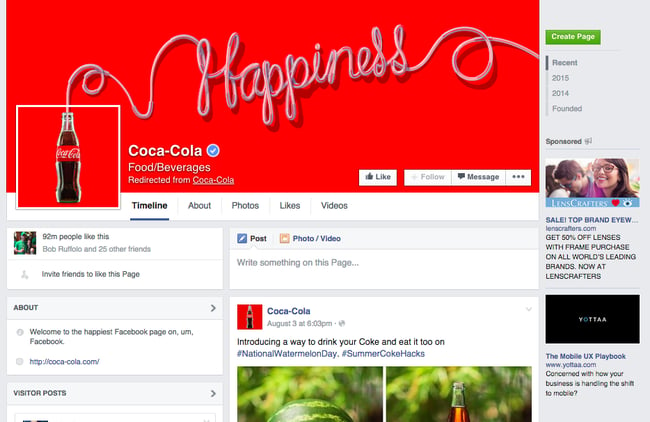
↓
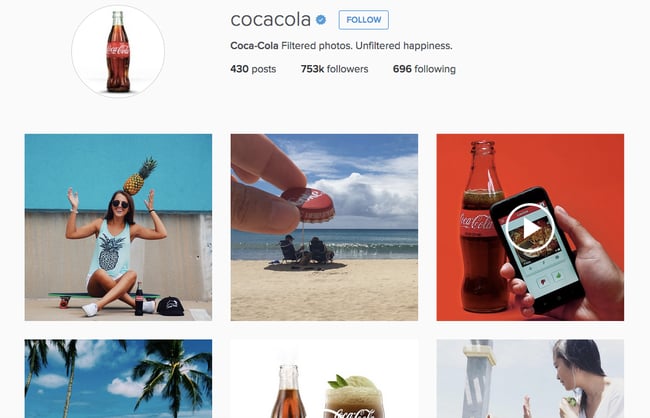
↓

↓
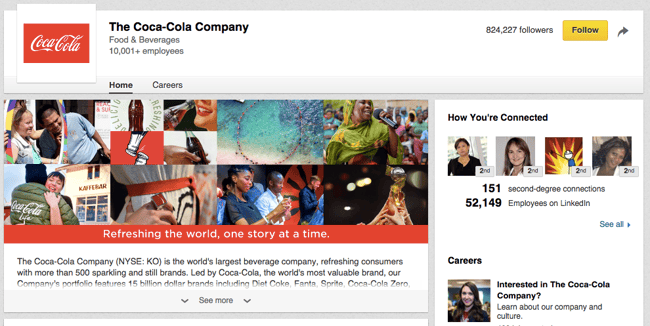
To avoid leaving potential customers struggling to put the disconnected pieces of your business together, consider the benefits of creating a style guide. A style guide can encompass everything from the tone of voice you'll use to the color scheme you'll employ to the way you'll position certain products or services.
By taking the time to define and agree upon these considerations, your brand will benefit as a whole. Want to learn more about style guides? Check out this article my colleague Austin Knight published on the web design style guides of big companies like Apple, Google, and Starbucks.
3) Emotion
Customers aren't always rational.
How else do you explain the person who paid thousands of dollars more for a Harley rather than buying another cheaper, equally well-made bike? There was an emotional voice in there somewhere, whispering: “Buy a Harley.”
But why?
Harley Davidson uses emotional branding by creating a community around their brand. They began HOG -- Harley Owners Group -- to connect their customers with their brand (and each other).
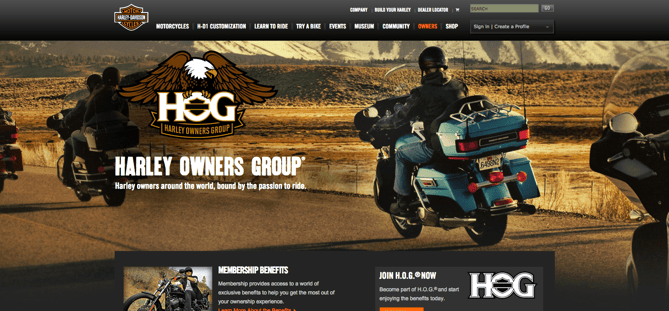
By provided their customers with an opportunity to feel like they're part of a larger group that's more tight-knit than just a bunch of motorcycle riders, Harley Davidson is able to position themselves as an obvious choice for someone looking to purchase a bike.
Why? People have an innate desire to build relationships. Research from psychologists Roy Baumeister and Mark Leary best describes this need in their "belongingness hypothesis," which states: "People have a basic psychological need to feel closely connected to others, and that caring, affectionate bonds from close relationships are a major part of human behavior."
Not to mention, belongingness -- the need for love, affection, and being part of groups -- falls directly in the middle of Maslow's hierarchy of needs, which aims to categorize different human needs.
The lesson to be learned? Find a way to connect to your customers on a deeper, more emotional level. Do you give them peace of mind? Make them feel like part of the family? Do you make life easier? Use emotional triggers like these to strengthen your relationship and foster loyalty.
4) Flexibility
In this fast-changing world, marketers must remain flexible to stay relevant. On the plus side, this frees you to be creative with your campaigns.
You may be thinking, "Wait a minute, how am I supposed to remain consistent while also being flexible?"
Good question. While consistency aims to set the standard for your brand, flexibility enables you to make adjustments that build interest and distinguish your approach from that of your competition.
In other words, "effective identity programs require enough consistency to be identifiable, but enough variation to keep things fresh and human," explains president of Peopledesign, Kevin Budelmann.
A great example of this type of strategic balance comes from Old Spice. These days, Old Spice is one of the best examples of successful marketing across the board. However, up until recently, wearing Old Spice was pretty much an unspoken requirement for dads everywhere. Today, they're one of the most popular brands for men of all ages.
Their secret? Flexibility.
Aware that they needed to do something to secure their place in the market, Old Spice teamed up with Wieden+Kennedy to position their brand for a new customer base.

Between new commercials, a new website, new packaging, and new product names, Old Spice managed to attract the attention of a new, younger generation by making strategic enhancements to their already strong brand.
So if your old tactics aren’t working anymore, don’t be afraid to change. Just because it worked in the past doesn't mean it's working now.
Take the opportunity to engage your followers in fresh, new ways. Are there some out-of-the-box partnerships your brand can make? Are there attributes about your product you never highlighted? Use those to connect with new customers and remind your old ones why they love you.
5) Employee Involvement
If your brand is playful and bubbly through Twitter engagements, then it wouldn't make sense if a customer called in and was connected with a grumpy, monotone representative, right?
To avoid this type of mismatched experience, take note of Zappos' approach.
If you've ever been on the line with a customer service representative from Zappos, you know what I'm talking about. If you haven't, check out this SlideShare which details some of their most inspiring customer support stories.
Zappos is so committed to ensuring that not only their brand, but all brands, remain consistent across digital and human interactions that they've dedicated an entire department to the cause called Zappos Insights.
6) Loyalty
If you already have people that love you, your company, and your brand, don’t just sit there. Reward them for that love.
These customers have gone out their way to write about you, to tell their friends about you, and to act as your brand ambassadors. Cultivating loyalty from these people early on will yield more returning customers -- and more profit for your business.
Sometimes, just a thank you is all that's needed. Other times, it's better to go above and beyond. Write them a personalized letter. Sent them some special swag. Ask them to write a review, and feature them prominently on your website. (Or all of the above!)
When we reached 15,000 customers here at HubSpot, we wanted to say thank you in a big way, while remaining true to our brand ... so we dropped 15,000 orange ping pong balls from our fourth floor balcony and spelled out thank you in big metallic balloons:
And while it may have seemed a little out of the ordinary to some folks, for those who know our brand, the gesture made perfect sense.
Loyalty is a critical part of every brand strategy, especially if you're looking to support your sales organization. At the end of the day, highlighting a positive relationship between you and your existing customers sets the tone for what potential customers can expect if they choose to do business with you.
7) Competitive Awareness
Take the competition as a challenge to improve your own strategy and create greater value in your overall brand. You are in the same business and going after the same customers, right? So watch what they do.
Do some of their tactics succeed? Do some fail? Tailor your brand positioning based on their experience to better your company.
A great example of how to improve your brand by learning from your competitors comes from Pizza Hut:

When a pizza lover posed this question to his Twitter following, Pizza Hut didn't miss a beat. They playfully responded in minutes, before Domino's had a chance to speak up.
If Domino's is keeping an eye on the competitors, they'll know to act fast the next time a situation like this arises.
For HubSpot customers, keeping tabs on your competitor's social mentions is easy using the Social Monitoring App. Check out this article to learn more about how to set up custom social streams.
And while staying in tune with your competitor's strategies is important if you want to enhance your brand, don't let them dictate each and every move you make.
Sure, you probably sell a similar product or service as many other companies, but you're in business because your brand is unique. By harping on every move your competitor makes, you lose that differentiation.
What other components do you focus on when building out a brand strategy? Let us know in the comments section below.
Editor's Note: This post was originally published in March 2012 and has been updated for freshness, accuracy, and comprehensiveness.
Brand associations and cobranding: 22 examples
We know that in order to enhance the brand equity of any brand, making brands associations are keys.
These associations reinforce the awareness as well as the brand positioning.
Here are 22 examples of such co-branding.
What is the difference between marketing and branding?
What is the difference between marketing and branding?
In a recent conversation with a very senior person at a financial institution my colleague was told, “I think private wealth managers will have a hard time seeing the value of branding—they see marketing as a cost center, not a driver of sales.”
Hold it.
How did we go from branding to marketing in one sentence like that?
What is marketing? What is branding? How do they differ?
There is a spectrum of opinions here, but in my view, marketing is actively promoting a product or service. It’s a push tactic. It’s pushing out a message to get sales results: “Buy our product because it’s better than theirs.” (Or because it’s cool, or because this celebrity likes it, or because you have this problem and this thing will fix it, etc.) This is oversimplification, but that’s it in a nutshell.
This is not branding.
Branding should both precede and underlie any marketing effort. Branding is not push, but pull. Branding is the expression of the essential truth or value of an organization, product, or service. It is communication of characteristics, values, and attributes that clarify what this particular brand is and is not.
A brand will help encourage someone to buy a product, and it directly supports whatever sales or marketing activities are in play, but the brand does not explicitly say “buy me.” Instead, it says “This is what I am. This is why I exist. If you agree, if you like me, you can buy me, support me, and recommend me to your friends.”
Branding is strategic. Marketing is tactical.
Marketing may contribute to a brand, but the brand is bigger than any particular marketing effort. The brand is what remains after the marketing has swept through the room. It’s what sticks in your mind associated with a product, service, or organization—whether or not, at that particular moment, you bought or did not buy.
The brand is ultimately what determines if you will become a loyal customer or not. The marketing may convince you to buy a particular Toyota, and maybe it’s the first foreign car you ever owned, but it is the brand that will determine if you will only buy Toyotas for the rest of your life.
The brand is built from many things. Very important among these things is the lived experience of the brand. Did that car deliver on its brand promise of reliability? Did the maker continue to uphold the quality standards that made them what they are? Did the sales guy or the service center mechanic know what they were talking about?
Marketing unearths and activates buyers. Branding makes loyal customers, advocates, even evangelists, out of those who buy.
This works the same way for all types of businesses and organizations. All organizations must sell (including nonprofits). How they sell may differ, and everyone in an organization is, with their every action, either constructing or deconstructing the brand. Every thought, every action, every policy, every ad, every marketing promotion has the effect of either inspiring or deterring brand loyalty in whomever is exposed to it. All of this affects sales.
Back to our financial expert. Is marketing a cost center? Poorly researched and executed marketing activities can certainly be a cost center, but well-researched and well-executed marketing is an investment that pays for itself in sales and brand reinforcement.
Is branding a cost center? On the surface, yes, but the return is loyalty. The return is sales people whose jobs are easier and more effective, employees who stay longer and work harder, customers who become ambassadors and advocates for the organization.
Branding is as vital to the success of a business or nonprofit as having financial coherence, having a vision for the future, or having quality employees.
It is the essential foundation for a successful operation. So yes, it’s a cost center, like good employees, financial experts, and business or organizational innovators are. They are cost centers, but what is REALLY costly is not to have them, or to have substandard ones.




